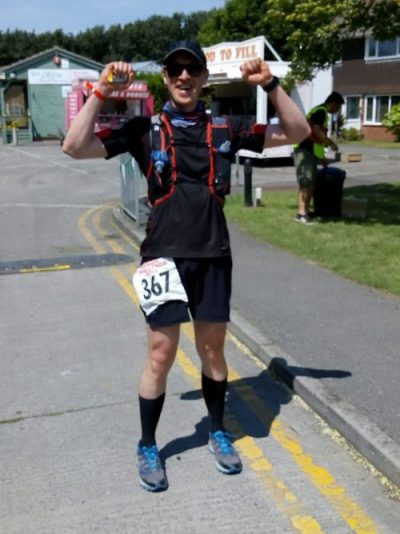
Maximising your athletic performance by staying hydrated this summer
The summer heat and humidity this year has been fabulous, but many of us are forgetting the golden rules on how to stay hydrated when active.
Given the right nutrition and planning you can continue to perform at your best.
I am a runner and when the sun shines I can’t think of anything better than putting my trainers on and heading up to my local trails to blast around beautiful scenery under blue skies.
I have been caught out many a time during trail events where I have not considered the days temperature, as well as my clothing choice and nutrition pre/during and post event. Like many other like minded runners I get carried away by the excitement of the days event.
Having recently ran the Mendip Challenge in 25 degree heat, my thoughts are very much on this very subject. Although I ran well and enjoyed the event, I witnessed many a participant with cramp, nausea and fatigue, no doubt, exacerbated on by the heat.
I now have a check list which I tick off each and every time I head out the door for a lengthy run. This is more important should your run take you on forest trails or remote areas, think Mendip’s and Quantock Hill’s, where help is not always nearby.
My tick list is as follows:
Check the weather
Always a good idea. Weather apps are pretty good at predicting weather across the day.
Use sun block
As a red head with fair skin I burn quickly. Sun burn is very uncomfortable and makes body temperature rise, a precursor to dehydration. The big problem I find with high factor sun cream is that it is thick and when you sweat the cream runs into my eyes and stings!
Breathability of the cream is another factor to consider. We sweat when our core temperature rises, as it evaporates off the skin, it acts as a coolant to the body. Sweat evaporates quickly, but with a layer of suncream on your skin, the sweat droplets tend to join together, forming larger droplets, which take longer to evaporate. You may have to experiment with different brands to find the one that suits you.
Dress for the day
Take a little time over this as in the heat you sweat more, which can cause friction and abrasion (think sensitive areas). Make sure your kit is of thinner material and able to create air flow around the body. This will help to keep you cool and maintain your temperature. The use of thinner socks are also a great consideration. For many, merino wool socks help stop chaffing and hot spots caused by friction. I swear by Injini 5 finger socks, no more blisters, phew! TIP: If you are running on a hot day, consider using talc between your toes and for those longer runs, invest in a good lubricant for places that rub (nipples, inner thighs) I tend to use Paw Paw ointment and Chamois Creme.
Know your limits
Exercise intensity raises heart rate and core temperature.
A hot day is not the best time for a personal best in time or distance. Keep a diary to monitor your progress and increase time or distance by 10% every few weeks. If you are in a training plan and on that day you have a longer run planned, try doing it early morning or later evening to avoid the hottest part of the day.
Plan your route
When the sun is high in the sky and it’s warm, plan your route to have shaded areas. Forest runs are great for this. The tree canopy provides much needed shade to keep your temperature down.
How to stay hydrated
Dehydration occurs when you loose more fluid than you take in and your body doesn’t have enough fluids or water to function properly. If you don’t replace these lost fluids during exercise, you will become dehydrated.
The difficulty is how to monitor how much fluid you need to keep hydrated, as the amount of fluid you loose during exercise depends on a variety of factors, including genetics and fitness level. As your body becomes accustomed to longer duration and frequency of training, the amount of fluid you need will reduce.
TIP: There is a two hour window before running where the body utilises fluids and prepares for exercise. This is the time to take on fluids, to hydrate the body ready for action.
During running
Invest in a good hand held bottle for drinking. There are plenty to choose from on the market. Ideally, you need fluid to be easily absorbed and palatable (water or sports drink).
Water is important, but absorbs too quickly in the body to replace the fluids that are lost.
A drink with combined sugars and salt (electrolytes: sodium, potassium, chloride, magnesium) slow down this absorption rate and replaces vital carbohydrates that are used for energy (muscle contraction and nerve conduction). Sweating is a by product of increased heat and functions to cool you down. Think of a cars radiator. Try to drip feed the body when running, especially if your run is over 1 hour.
TIP: A fruit drink of 500ml such as apple juice with (quarter or third) part water and a good pinch of salt works well for me, or you could empty a sachet of rehydration salts into your water bottle.
Excess packing
For those longer runs I always keep bottled water in the car, a change of clothing, a sponge (for dowsing yourself!) and some nutrition (food).
Nutrition
For the longer runs. Real food works best for me. This is very personal, as what works for me may not work for you. Experiment with food and gels over the course of time. Your body will let you know what works!!
After running
Drink and eat to replenish (electrolytes), refuel (carbohydrates), repair (protein). The first 15 / 30 minutes post exercise are vital in stocking up on these lost fluids. I usually consume a whey protein drink with milk and banana and ensure I eat a good carbohydrate based meal to replenish my glycogen stores. This works for me, experiment with what works for you and it will depend on the type of sport you are doing.
How to monitor dehydration
The colour of your urine is always a good indictor of how well the body is performing. Ideally urine should be straw coloured. Darker urine is a sign you are dehydrated.
If you need to pee, it’s quite a strong message to the body i.e. you don’t forget once this message has been received! So if you are not peeing during or after exercise, the chances are that you’re dehydrated.
Who is more affected
The following is not an exhaustive list, but details common reasons for dehydration.
Take responsibility, prepare for sport, especially in the heat.
Dehydration can happen more easily if you have:
Diabetes
Vomiting/ Diarrhoea
Heatstroke/ sunburn
Too much alcohol (night / days before)
Increased sweating
Taking medicines that make you pee more (Diuretics)
If you’ve done all of that, then what are you waiting for? Get out there!
Zac Beard is a registered osteopath at Nimble Osteopathy.
If you would like to discuss your aches, pains and sporting injuries please call us on 01275 750207 to make an appointment or book in for a free 15 minute consultation.


Recent Comments